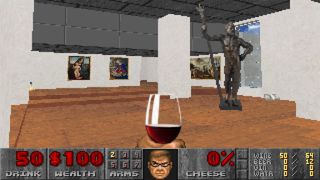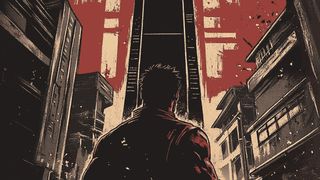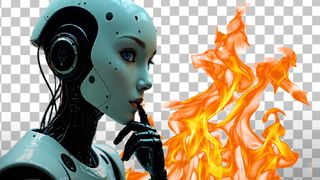The 3D secrets behind hip anime series RBWY
Monty Oum, director of animation for Rooster Teeth, explains how 3D helped to bring dynamic visuals and depth to anime action series RWBY.
During the tail end of production on season seven of Red vs Blue, Rooster Teeth's flagship series, I joined the studio as as director of animation. Having been a fan of Red vs Blue for many years, I knew there were areas where I could apply my abilities to augment the show's action, humour and visual appeal.
A few successful seasons later, while wrapping up production on the 10th season of Red vs Blue, I started looking for my next challenge. I came up with a concept for an entirely new type of show, one that would meld the Eastern philosophies and visual style of anime with more Western sensibilities and traditions of folklore.
Five turning points in RWBY
01. We wanted choreographed fights with depth and complexity
The name of the show and core characters came to me in a flash while I was half-awake during one of my many 35-hour-long marathon animation sessions. I called it RWBY and immediately pitched it to our CEO, Matt Hullum, and creative director, Burnie Burns. All they wanted to know was if it would have a bunch of crazy action scenes with wildly elaborate fight choreography. That was an easy 'yes' for me.
As soon as we wrapped production on season 10 of Red vs Blue, I started working independently on the first RWBY trailer. I was looking forward to defining the visual style of the show as much as I was to developing a production method in which to produce it. In many ways, the art and technique had to be developed simultaneously.
My vision for the show was to present a two-dimensional, toon-shaded look, but with all of the depth and complexity of a 3D-animated production. I wanted to be able to move the cameras and characters freely while still capturing the essence of the flat, line-drawn look of traditional anime.

02. Using Poser gave us the power to animate cool visuals
My work has always required an unconventional form of thinking and an unconventional application. Many people are often surprised to hear that most of my work is done in Smith Micro's Poser. Poser has been my primary program for the last 14 years. My work in the last three seasons of Red vs Blue, and all of RWBY, has been animated almost entirely in Poser.
As a 3D program, Poser might not have some of the superfluous bells and whistles of the more commonly used applications, but I’m a big believer in the idea that a streamlined interface can lead to greater efficiency. From a production standpoint it’s hard to ignore the volume of work my team and I have been able to create. There have been episodes of Red vs Blue that have been completely animated in only a week’s time by myself and only one other animator.
03. We pushed boundaries and broke the rules
With RWBY, we’re attempting to take our intense productivity up to an even higher level. Working with our producer Kathleen Zuelch, animator Shane Newville and technical director Jeff Yohn, we’ve created a pipeline that focuses the unique features of the Poser application on the unconventional demands of this show.
From pushing blend shapes past their breaking point to repurposing OBJ sequences in unexpected ways, I try to challenge the team to embrace solutions regardless of whether they are considered technically correct. If it’s not in the manual but it still gets the job done, I’m all for it.
Poser is used as the primary animation app. All assets are usually built in Maya including characters, props and sets. They are then imported into Poser for rigging and texturing. We utilise OptiTrack’s Arena software, which comes with one of their motion capture packages. We capture and export BVH data onto the Poser rigs and do most of the clean-up and performance editing in Poser. That also includes the facial animation, which is done with blend shapes and Poser’s built in Talk Designer tool. Once a scene is finished, the export can be as simple as a single layer with all assets live exported an image sequence, or several different layers depending on the complexity of effects.
Whenever a technical hurdle presents itself, the challenge tends to be not in overcoming it, but rather about how to find a creative way around it. Lateral thinking has always been the modus operandi of 3D, and the expanded freedom that comes from a wider view on storytelling itself is makes you a filmmaker. If I don’t have access to a certain type of rigging, then I simply don’t design characters that need that rig. Often, instead of making an animation work from several angles, I’ll design for a specific angle and make sure that I can get what I need from that single perspective. If the deadline is fast approaching and I’m short on the shots I think I need, I simply work with our writers Kerry Shawcross and Miles Luna to re-imagine the scene.
When I’m working on my own, I tend to run editorial and animation concurrently. I’m averse to storyboards and over-planning. I like to talk about traditional 3D pipelines as being akin to baking: everything is very deliberate and methodical. My version of 3D animation is more like stir-frying. It’s very live and in the moment. If I need a model, I make a model. If a shot or sequence isn’t working, I’ll cut it, move it, or use it later - sometimes several years later.

04. We wanted to achieve perfection and in doing so, put too much detail in when it wasn't needed
On RWBY, limitations are the name of the game, both technically and artistically. I'll often be making a model or set and realise I’m putting far more detail into it than is necessary. Or, I will motion-capture a performance and get several thousand frames only to use 10 of them. Anime, and perhaps much of art itself, comes from not being able to achieve realism easily in the chosen medium. This means we need to find ways to make 3D, which aims for realism by default, work in more artistically constrained ways.
Many of the creative choices in RWBY come from researching the methods anime uses to tell stories. Working from that rule book means that I can do as little work as possible to effectively tell the story. There were several years of research and development that went into exploring what the eye will accept as the minimum for a believable performance. This minimum requirement is an ever-shifting target as the landscape of media constantly evolves.
05. We produced lines using geometry so the artists could be in control
The first notable achievements in my RWBY R&D were discovering how to create a line and how to deal with shadows. I have a general distrust for technology and will always put my stake in an artist having direct control. I think there's very little use for toon shaders or procedural line drawing methods. All of the line work on RWBY is done directly through geometry. All of the colours are determined directly in the texture. On RWBY, lines are drawn by exploiting an error with back-faced culling: Wherever there needs to be a line, there is a second set of the same geometry slightly extruded and often coloured black to simulate a line. Having the two sets of geometry adjacent and occluding each other gives the perception of a line.
Lines and colours, the barest of bare essentials, give the impression of the representation of a person on screen. Much of the rest of our workflow falls into the typical 3D categories: blend shapes for facial animation, basic rigging, and weighting for characters and props. Our sets are built much like game stages, with the lighting baked in. The entire rendering for the show is done via playblasts, so what you see in your viewport is exactly what you get in your export.
Unconventional methods pay off
RWBY aims to exploit the two key minimalist storytelling tools utilised across the history of anime: the impression of movement and the impression of detail. By combining those tools with the power of 3D, in a genre that is built mostly in the imagination, it leaves me with as little work as possible. This then allows Team RWBY to create a much more expansive world than would otherwise be possible.

Taking our animation department in such an unconventional direction might be considered a risky, maybe even a bold, decision. However, that’s what we do here, and usually, it pays off.
VITAL STATISTICS
Project: RWBY (pronounced Ruby)
Studio: Rooster Teeth Productions
Format: Online
Client: Rainmaker Entertainment
Time taken: In progress (Estimated 12 months)
Team size: 15-20 at its peak
Software used: Poser Pro, Maya, ZBrush, Softimage, 3ds Max, After Effects, Premiere, Photoshop, particleIllusion
Release date: 5 July 2013 (RTX premiere), 18 July 2013 (online)
Words: Monty Oum
Monty Oum is the director of animation for Rooster Teeth. Prior to creating the exciting and elaborate fight sequences for Red vs Blue, Oum created the online series Dead Fantasy and Haloid. He is currently directing Rooster Teeth’s first anime series, RWBY.
This article originally appeared in 3D World issue 172.
Liked this? Read these!
- Get a load of the best 3D movies of 2013
- Discover what's next for Augmented Reality
- Check out this selection of top TV commercials
Does RBWY pack enough punch? Let us know in the comments.

Thank you for reading 5 articles this month* Join now for unlimited access
Enjoy your first month for just £1 / $1 / €1
*Read 5 free articles per month without a subscription

Join now for unlimited access
Try first month for just £1 / $1 / €1
Get the Creative Bloq Newsletter
Daily design news, reviews, how-tos and more, as picked by the editors.
The Creative Bloq team is made up of a group of design fans, and has changed and evolved since Creative Bloq began back in 2012. The current website team consists of eight full-time members of staff: Editor Georgia Coggan, Deputy Editor Rosie Hilder, Ecommerce Editor Beren Neale, Senior News Editor Daniel Piper, Editor, Digital Art and 3D Ian Dean, Tech Reviews Editor Erlingur Einarsson and Ecommerce Writer Beth Nicholls and Staff Writer Natalie Fear, as well as a roster of freelancers from around the world. The 3D World and ImagineFX magazine teams also pitch in, ensuring that content from 3D World and ImagineFX is represented on Creative Bloq.
Related articles
-

-

-

-

